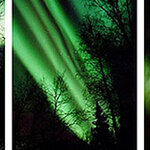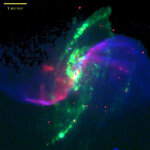Space

Cluster is providing new insights into the working of a ‘space tsunami’ that plays a role in disrupting the calm and beautiful aurora, or northern lights, creating patterns of auroral dances in the sky.
The image to the left is the typical appearance of the aurora before a magnetic substorm. During a substorm, the single auroral ribbon may split into several ribbons (centre) or even break into clusters that race north and south (right). Credits: Jan Curtis
Generally seen in high-latitude regions such as Scandinavia or Canada, aurorae are colourful curtains of light that appear in the sky.…
ESA's Darwin mission aims to discover extrasolar planets and examine their atmospheres for signs of life, particularly for the presence of certain life-related chemicals such as oxygen and carbon dioxide. The major technical challenge lies in distinguishing, or resolving, the light from an extrasolar planet from the hugely overwhelming radiation emitted by the planet's nearby star.
Darwin will combine light from four or five telescopes and send it down to Earth. Credits: ESA
The multi-satellite Darwin mission will use optical interferometry in which at least three separate orbiting…
A remarkable eclipse of a supermassive black hole and the hot gas disk around it has been observed with NASA's Chandra X-ray Observatory. This eclipse has allowed two key predictions about the effects of supermassive black holes to be tested.
Just as eclipses of the Sun and moon give astronomers rare opportunities to learn about those objects, an alignment in a nearby galaxy has provided a rare opportunity to investigate a supermassive black hole.
The large image shows an optical view of NGC 1365 from the ESO Very Large Telescope and the inset shows the Chandra X-ray Observatory view of the…

Earth's polar regions. These clouds have grown brighter and more prevalent in recent years and some scientists suggest that changes in these clouds may be the result of climate change.
The first opportunity for launch is on Wednesday, April 25 from Vandenberg Air Force Base, Calif., aboard a Pegasus launch vehicle.
AIM will conduct the first detailed probe of this unusual phenomenon typically observed approximately 50 miles above the Earth's surface in the mesosphere. The mesosphere is the region just above the stratosphere. Researchers know very little about how these polar mesospheric…

Some believe it is just a figment of overactive imaginations. But evidence is growing that the so-called "axis of evil" – a pattern apparently imprinted on the radiation left behind by the big bang – may be real, posing a threat to standard cosmology.
According to the standard model, the universe is isotropic, or much the same everywhere. The first sign that this might not be the case came in 2005, when Kate Land and João Magueijo of Imperial College London noticed a curious pattern in the map of the cosmic microwave background (CMB) created by NASA’s WMAP satellite. It seemed to show that…

Using a trio of space observatories, astronomers may have cracked a 45-year old mystery surrounding two ghostly spiral arms in the galaxy M106 (NGC 4258).
The results, obtained by a team from the University of Maryland (USA), took advantage of the unique capabilities of the European Space Agency’s XMM-Newton X-ray observatory, NASA’s Chandra X-ray Observatory, and NASA’s Spitzer Space Telescope.
This is a composite image of spiral galaxy M106 (NGC 4258). Optical data from the Digitized Sky Survey is shown in yellow, radio data from the Very Large Array appears purple, X-ray data from…

The double sunset that Luke Skywalker gazed upon in the film "Star Wars" might not be a fantasy.
Astronomers using NASA's Spitzer Space Telescope have observed that planetary systems – dusty disks of asteroids, comets and possibly planets – are at least as abundant in twin-star systems as they are in those, like our own, with only one star. Since more than half of all stars are twins, or binaries, the finding suggests the universe is packed with planets that have two suns. Sunsets on some of those worlds would resemble the ones on Luke Skywalker's planet, Tatooine, where two fiery balls dip…

Astronomers using data from several X-ray satellites have caught a magnetar – the remnant of a massive star with an incredibly strong magnetic field – in a sort of giant cosmic blench.
When it comes to eerie astrophysical effects, the neutron stars commonly known as magnetars are hard to beat. The massive remnants of exploded stars, magnetars are the size of mountains but weigh as much as the sun, and have magnetic fields hundreds of trillions of times more powerful than the Earth's, which pushes our compass needles north.
The left panel shows the image of the field before the burst. The…
In a galaxy far, far away, a massive star suffered a nasty double whammy. On Oct. 20, 2004, Japanese amateur astronomer Koichi Itagaki saw the star let loose an outburst so bright that it was initially mistaken for a supernova. The star survived, but for only two years. On Oct. 11, 2006, professional and amateur astronomers witnessed the star actually blowing itself to smithereens as Supernova 2006jc.
Swift Ultraviolet/Optical Telescope image of Supernova 2006jc in the galaxy UGC 4904 in three filters. Click image to enlarge. Credit: NASA/Swift/S. Immler
"We have never observed a stellar…
NGC 1672, visible from the Southern Hemisphere, is seen almost face on and shows regions of intense star formation. The greatest concentrations of star formation are found in the so-called starburst regions near the ends of the galaxy's strong galactic bar. NGC 1672 is a prototypical barred spiral galaxy and differs from normal spiral galaxies in that the spiral arms do not twist all the way into the centre. Instead, they are attached to the two ends of a straight bar of stars enclosing the nucleus.
The barred spiral galaxy NGC 1672, showing up clusters of hot young blue stars along its…